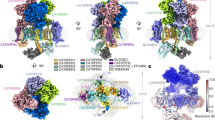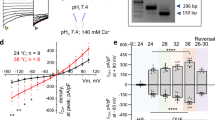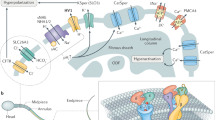Abstract
A clinically significant proportion of couples experience difficulty in conceiving a child. In about half of these cases male infertility is the cause and often genetic factors are involved. Despite advances in clinical diagnostics ∼50% of male infertility cases remain idiopathic. Based on this, further analysis of infertile males is required to identify new genetic factors involved in male infertility. This review focuses on cation channel of sperm (CATSPER)-related male infertility. It is based on PubMed literature searches using the keywords ‘CATSPER’, ‘male infertility’, ‘male contraception’, ‘immunocontraception’ and ‘pharmacologic contraception’ (publication dates from January 1979 to December 2009). Previously, contiguous gene deletions including the CATSPER2 gene implicated the sperm-specific CATSPER channel in syndromic male infertility (SMI). Recently, we identified insertion mutations of the CATSPER1 gene in families with recessively inherited nonsyndromic male infertility (NSMI). The CATSPER channel therefore represents a novel human male fertility factor. In this review we summarize the genetic and clinical data showing the role of CATSPER mutation in human forms of NSMI and SMI. In addition, we discuss clinical management and therapeutic options for these patients. Finally, we describe how the CATSPER channel could be used as a target for development of a male contraceptive.
Similar content being viewed by others
Log in or create a free account to read this content
Gain free access to this article, as well as selected content from this journal and more on nature.com
or
References
Matzuk MM, Lamb DJ : The biology of infertility: research advances and clinical challenges. Nat Med 2008; 14: 1197–1213.
Templeton A, Fraser C, Thompson B : The epidemiology of infertility in Aberdeen. BMJ 1990; 301: 148–152.
Mosher W, Pratt W : Fecundity and Infertility in the United States, 1965–1988. Advanced Data from Vital and Health Statistics. Hyattsville: National Center for Health Statistics, 1990.
Skakkebaek NE, Giwercman A, de Kretser D : Pathogenesis and management of male infertility. Lancet 1994; 343: 1473–1479.
Pryor JL, Kent-First M, Muallem A et al: Microdeletions in the Y chromosome of infertile men. N Engl J Med 1997; 336: 534–539.
Shah K, Sivapalan G, Gibbons N, Tempest H, Griffin DK : The genetic basis of infertility. Reproduction 2003; 126: 13–25.
Arce B, Padron S : Spermatogenesis in Klinefelter's syndrome. Reproduction 1980; 4: 177–184.
Grabski J, Pusch H, Schirren C et al: [Clinical, endocrinological, histological and chromosomal investigations on Klinefelter's syndrome]. Andrologia 1979; 11: 182–196.
Turner RM, Musse MP, Mandal A et al: Molecular genetic analysis of two human sperm fibrous sheath proteins, AKAP4 and AKAP3, in men with dysplasia of the fibrous sheath. J Androl 2001; 22: 302–315.
Chemes HE, Brugo S, Zanchetti F, Carrere C, Lavieri JC : Dysplasia of the fibrous sheath: an ultrastructural defect of human spermatozoa associated with sperm immotility and primary sterility. Fertil Steril 1987; 48: 664–669.
Zuccarello D, Ferlin A, Cazzadore C et al: Mutations in dynein genes in patients affected by isolated non-syndromic asthenozoospermia. Hum Reprod 2008; 23: 1957–1962.
Schwabe GC, Hoffmann K, Loges NT et al: Primary ciliary dyskinesia associated with normal axoneme ultrastructure is caused by DNAH11 mutations. Hum Mutat 2008; 29: 289–298.
Carlson AE, Westenbroek RE, Quill T et al: CatSper1 required for evoked Ca2+ entry and control of flagellar function in sperm. Proc Natl Acad Sci USA 2003; 100: 14864–14868.
Navarro B, Kirichok Y, Chung JJ, Clapham DE : Ion channels that control fertility in mammalian spermatozoa. Int J Dev Biol 2008; 52: 607–613.
Avenarius MR, Hildebrand MS, Zhang Y et al: Human male infertility caused by mutations in the CATSPER1 channel protein. Am J Hum Genet 2009; 84: 505–510.
Zhang Y, Malekpour M, Al-Madani N et al: Sensorineural deafness and male infertility: a contiguous gene deletion syndrome. J Med Genet 2007; 44: 233–240.
Avidan N, Tamary H, Dgany O et al: CATSPER2, a human autosomal nonsyndromic male infertility gene. Eur J Hum Genet 2003; 11: 497–502.
Jin J, Jin N, Zheng H et al: Catsper3 and Catsper4 are essential for sperm hyperactivated motility and male fertility in the mouse. Biol Reprod 2007; 77: 37–44.
Qi H, Moran MM, Navarro B et al: All four CatSper ion channel proteins are required for male fertility and sperm cell hyperactivated motility. Proc Natl Acad Sci USA 2007; 104: 1219–1223.
Lobley A, Pierron V, Reynolds L, Allen L, Michalovich D : Identification of human and mouse CatSper3 and CatSper4 genes: characterisation of a common interaction domain and evidence for expression in testis. Reprod Biol Endocrinol 2003; 1: 53.
Ren D, Navarro B, Perez G et al: A sperm ion channel required for sperm motility and male fertility. Nature 2001; 413: 603–609.
Quill TA, Ren D, Clapham DE, Garbers DL : A voltage-gated ion channel expressed specifically in spermatozoa. Proc Natl Acad Sci USA 2001; 98: 12527–12531.
Kirichok Y, Navarro B, Clapham DE : Whole-cell patch-clamp measurements of spermatozoa reveal an alkaline-activated Ca2+ channel. Nature 2006; 439: 737–740.
Lishko PV, Botchkina IL, Fedorenko A, Kirichok Y : Acid extrusion from human spermatozoa is mediated by flagellar voltage-gated proton channel. Cell 2010; 140: 327–337.
Nikpoor P, Mowla SJ, Movahedin M, Ziaee SA, Tiraihi T : CatSper gene expression in postnatal development of mouse testis and in subfertile men with deficient sperm motility. Hum Reprod 2004; 19: 124–128.
Li HG, Ding XF, Liao AH, Kong XB, Xiong CL : Expression of CatSper family transcripts in the mouse testis during post-natal development and human ejaculated spermatozoa: relationship to sperm motility. Mol Hum Reprod 2007; 13: 299–306.
Verpy E, Masmoudi S, Zwaenepoel I et al: Mutations in a new gene encoding a protein of the hair bundle cause non-syndromic deafness at the DFNB16 locus. Nat Genet 2001; 29: 345–349.
Villamar M, del Castillo I, Valle N, Romero L, Moreno F : Deafness locus DFNB16 is located on chromosome 15q13-q21 within a 5-cM interval flanked by markers D15S994 and D15S132. Am J Hum Genet 1999; 64: 1238–1241.
Carlson AE, Quill TA, Westenbroek RE, Schuh SM, Hille B, Babcock DF : Identical phenotypes of CatSper1 and CatSper2 null sperm. J Biol Chem 2005; 280: 32238–32244.
WHO: World Health Organization Laboratory Manual for the Examination of Human Semen and Sperm-cervical Mucus Interaction. Cambridge: Cambridge University Press, 1999.
Hildebrand MS, Avenarius MR, Smith RJ : CATSPER-Related Male Infertility. Seattle: University of Washington, 2009.
Bonduelle M, Camus M, De Vos A et al: Seven years of intracytoplasmic sperm injection and follow-up of 1987 subsequent children. Hum Reprod 1999; 14: 243–264.
PCoASfRMPCoSfAR Technology: Genetic considerations related to intracytoplasmic sperm injection (ICSI). Fertil Steril 2008; 90: S182–S184.
Palermo GD, Colombero LT, Schattman GL, Davis OK, Rosenwaks Z : Evolution of pregnancies and initial follow-up of newborns delivered after intracytoplasmic sperm injection. JAMA 1996; 276: 1893–1897.
Bonduelle M, Wennerholm UB, Loft A et al: A multi-centre cohort study of the physical health of 5-year-old children conceived after intracytoplasmic sperm injection, in vitro fertilization and natural conception. Hum Reprod 2005; 20: 413–419.
Nieschlag E, Henke A : Hopes for male contraception. Lancet 2005; 365: 554–556.
Nass S, Strauss J : New Frontiers in Contraceptive Research: A Blueprint for Action. Washington, DC: Institute of Medicine National Academy Press, 2004.
Martin CW, Anderson RA, Cheng L et al: Potential impact of hormonal male contraception: cross-cultural implications for development of novel preparations. Hum Reprod 2000; 15: 637–645.
Carlson AE, Burnett LA, del Camino D et al: Pharmacological targeting of native CatSper channels reveals a required role in maintenance of sperm hyperactivation. PLoS One 2009; 4: e6844.
Aitken RJ : Immunocontraceptive vaccines for human use. J Reprod Immunol 2002; 57: 273–287.
Bronson R, Cooper G, Rosenfeld D : Sperm antibodies and infertility. Fertil Steril 1982; 37: 449–451.
Li H, Ding X, Guan H, Xiong C : Inhibition of human sperm function and mouse fertilization in vitro by an antibody against cation channel of sperm 1: the contraceptive potential of its transmembrane domains and pore region. Fertil Steril 2009; 92: 1141–1146.
Lang B, Vincent A : Autoantibodies to ion channels at the neuromuscular junction. Autoimmun Rev 2003; 2: 94–100.
Zhang D, Gopalakrishnan M : Sperm ion channels: molecular targets for the next generation of contraceptive medicines? J Androl 2005; 26: 643–653.
Hershlag A, Cooper GW, Benoff S : Pregnancy following discontinuation of a calcium channel blocker in the male partner. Hum Reprod 1995; 10: 599–606.
ARSM Practice Committee: Report on optimal evaluation of the infertile male. Fertil Steril 2006; 86: S202–S209.
Acknowledgements
R Smith is the Sterba Hearing Research Professor, University of Iowa College of Medicine, supported financially by NIH grants RO1 DC03544, RO1 DC02842 and RO1 DK074409. M Hildebrand was supported by an Australian National Health and Medical Research (NHMRC) Postdoctoral Training Fellowship.
Author information
Authors and Affiliations
Corresponding author
Ethics declarations
Competing interests
The authors declare no conflict of interest.
Additional information
Author contributions
MSH, MRA and MF designed the review; YZ, NCM, JA, CS, KK and HN compiled and analyzed clinical data; and MSH, MRA, MF, JSB and RJHS wrote the article.
Rights and permissions
About this article
Cite this article
Hildebrand, M., Avenarius, M., Fellous, M. et al. Genetic male infertility and mutation of CATSPER ion channels. Eur J Hum Genet 18, 1178–1184 (2010). https://doi.org/10.1038/ejhg.2010.108
Received:
Revised:
Accepted:
Published:
Issue date:
DOI: https://doi.org/10.1038/ejhg.2010.108
Keywords
This article is cited by
-
Advances in the study of genetic factors and clinical interventions for fertilization failure
Journal of Assisted Reproduction and Genetics (2023)
-
Association of CATSPER1, SPATA16 and TEX11 genes polymorphism with idiopathic azoospermia and oligospermia risk in Iranian population
BMC Medical Genomics (2022)
-
In silico analysis of microRNA genes in azoospermia factor Y-chromosome microdeletions
International Urology and Nephrology (2022)
-
SOX11-dependent CATSPER1 expression controls colon cancer cell growth through regulation the PI3K/AKT signaling pathway
Genes & Genomics (2022)
-
The effects of Vitamin D3 supplementation on Spermatogram and endocrine factors in asthenozoospermia infertile men: a randomized, triple blind, placebo-controlled clinical trial
Reproductive Biology and Endocrinology (2021)



